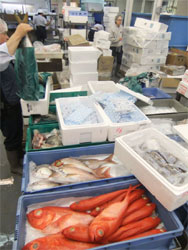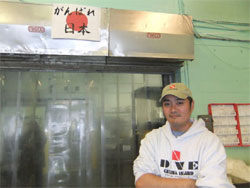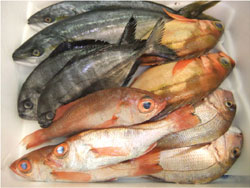Reports and Statistics
Distributing Japanese seafood purchased directly from local fishing markets to the U.S.: International Marine Products (USA)
October 28, 2011
JETRO Los Angeles
International Marine Products (IMP), headquartered in Los Angeles, is a wholesaler whose primary focus is fresh seafood and processed seafood products from Japan. It purchases fresh seafood at dockside in Japanese fishing markets for immediate export of highly fresh seafood to the U.S.A. On September 30, JETRO interviewed IMP's marketing manager, Yoshihiro Momose, about its initiatives to date, including those taken before the earthquake, and what its future directions will be.
The following is a brief summary of Mr. Momose's remarks.
Exporting fresh seafood purchased directly from local markets
IMP's goal is to import extremely fresh seafood from fishing markets throughout Japan and supply it to the U.S.. We began researching the U.S. market in 2010 and have conducted business discussions in many places since then.
We considered two approaches to supplying exceptionally fresh Japanese seafood to the U.S.A.
One was to shorten the lead time between buying and selling at the Tsukiji fish market in Tokyo. Instead of buying local marine products at Tsukiji, we began to buy directly from the local fish markets, then putting our purchases together ourselves at Tsukiji for shipment to the U.S. At this point, that has reduced the lead time by 20 to 25 hours. The other was to rethink how to store seafood to keep it fresh from the time we purchase it at each local market until it reaches the U.S.A.
Both approaches are now bearing fruit. We have begun delivering fresh seafood from all over Japan to the U.S.A. We are also vigorously promoting exports of local sake (Japanese rice wine) that goes well with each of our seafood products and are confident that this effort will also succeed.

IMP Wholesale Fish Market

Mr. Momose at IMP
Visited Japan just after the earthquake to provide customers with first-hand information
We arrived in Japan on March 15, a few days after the earthquake, for a trip to visit fishing communities throughout Japan. We started by visiting seafood markets in western Japan. We had been planning to visit the Aomori area first, but we made a sudden change in our plans after the March 11 earthquake. There were those who said that we should not go to Japan. We believed, however, that it was necessary to travel to Japan, to see and hear for ourselves the current state of seafood markets in Japan, and to communicate this information to restaurants and other buyers and consumers in the U.S.A.
After returning to the U.S.A., we immediately put together a report explaining what we had found and provided it to our customers, including supermarkets and restaurants. Soon after, to promote understanding of the safety of our fish and shellfish and answer fears aroused by the nuclear power accident in Fukushima, we displayed the results of Customs and Border Patrol (CBP) and Food and Drug Administration (FDA) radiation surveys, together with data provided by a research laboratory specializing in radiation, posting it conspicuously where our seafood is sold and also posting the same information on our website as well. We continued these efforts for a month and a half or two months, until things had calmed down somewhat and the situation had stabilized.
Meeting kindred spirits through JETRO business conferences
In June, when fears that Japanese fish and seafood were tainted with radioactive pollution had subsided and the U.S. government had announced that imports of fish and shellfish from Japan would not be banned, we returned to Japan to resume our visits to fishing communities throughout Japan.
During this trip, from July 31 to August 10, we participated in JETRO business conferences for food products exporters in Tokyo, Nagano, and Hokkaido. We met sellers of local seafood and sake products renowned for their local flavor and quality, conducted many fruitful negotiations, and laid plans to work together on expanding exports of Japanese food products to the U.S.A.
It will be hard to expand consumption of Japanese food products in the U.S.A. further without a parallel effort to grow awareness of Japanese cuisine. Unless those involved are willing to visit the U.S.A. several times a year, to go with us to see and hear about the current state of the market and get a visceral sense of local conditions, there is a high probability that efforts to export Japanese food products to the U.S. market will go astray.
We returned to the U.S.A. with renewed awareness of the concerns of local suppliers and renewed determination to supply local products from Japan to the U.S. market.
Making local purchasing a reality
Shipping local seafood to Tsukiji to buy and sell it, there is a system that has been in place for two decades and had come to be taken for granted. When we first began to implement our two approaches for improving the export of fresh seafood to the U.S., direct local purchasing and improved storage and shipping methods, and went to discuss our ideas at local fish markets, there were always those who said, “We've never considered that” or “It's not possible.” Others, however, understood what we are trying to do by combining these two approaches. Now our direct local purchase system has become a reality, with purchasing at the central seafood markets in Kanazawa, Aomori, Hachinohe, and Sapporo.
It is our mission to offer our customers in the U.S.A. reliably fresh and high quality food products from Japan. We cannot continue to use the same methods used for the last ten or twenty years. Our market is always looking for new approaches.
What we eat is an integral part of our culture. We who are involved in Japanese cuisine cannot treat it lightly. We must continue to promote authentic Japanese food and authentic Japanese culture in the U.S.A. and hand on this passion to the next generation.
Mr. Momose's report on post-Tohoku earthquake conditions in Japan can be found on the IMP website .

Fish purchased directly in Kanazawa



